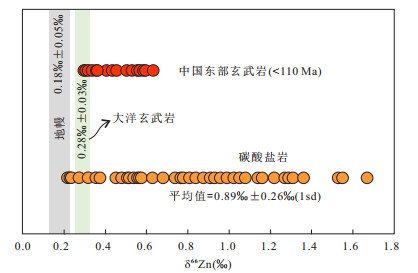Advances on Application of Zinc Isotope as a Tracer for Deep Carbon Cycles
-
摘要: 深部碳循环和地球表层的碳循环一起构成了全球的碳循环.因为地球超过90%的碳都位于深部,深部碳循环研究对于理解地球长期的气候变化具有重要的科学意义.深部碳循环研究涉及多个科学问题,其中最重要的科学问题之一是如何准确识别地幔中的碳是再循环的地表碳.锌作为亲石元素,广泛存在于岩浆岩、地幔和碳酸盐岩中.地幔和地表沉积碳酸盐岩之间锌同位素组成存在显著的差异,而板块俯冲脱水、地幔部分熔融和岩浆结晶分异等过程导致的锌同位素分馏较为有限,因此锌同位素具有示踪深部碳循环的潜力.系统阐述了锌同位素示踪深部碳循环的原理,回顾了目前应用锌同位素示踪深部碳循环取得的阶段性成果,并指出锌、镁同位素联合示踪有望成为未来深部碳循环研究的主流.Abstract: The deep carbon cycle and surface's carbon cycle together constitute the global carbon cycle. Research on deep carbon cycles is of significance for understanding the long-term climate change of the Earth given that >90% of Earth's carbon is stored in the deep Earth. Research on deep carbon cycles involves many aspects, among which one of the most important scientific issues is how to accurately identify recycled surface carbon in the mantle. Zinc (Zn) is a lithophile element and widely distributed in igneous rocks, mantle and sedimentary carbonates. There is a large Zn isotope difference between marine carbonates and the terrestrial mantle. Also, subduction-related dehydration, partial melting and magmatic differentiation only result in limited Zn isotope fractionation. Thus, Zn isotope has the potential as a novel tracer for deep carbon cycles. In this paper, the principle and potentiality of Zn isotope utilized as a tracer for deep carbon cycle are reviewed and the advances of using Zn isotope to trace deep carbon cycles in previous studies are presented. In addition, the combination between Zn and magnesium (Mg) isotopes is expect to the essential aspect of the deep carbon cycles in the future.
-
Key words:
- deep carbon cycle /
- Zn isotope /
- mantle /
- carbonate /
- geochemistry
-
图 1 地幔橄榄岩、碳酸盐岩和中国东部 < 110 Ma玄武岩的锌同位素组成
数据来源:碳酸盐岩(Pichat et al., 2003;Liu et al., 2017b;Sweere et al., 2018;Wang et al., 2018a);中国东部玄武岩(Liu et al., 2016;Wang et al., 2017);地幔(Wang et al., 2017;Sossi et al., 2018);大洋玄武岩(Chen et al., 2013;Wang et al., 2017)
Fig. 1. The zinc isotope compositions of mantle peridotites, carbonatites, and basalts of eastern China (< 110 Ma)
-
Aubaud, C., Pineau, F., Hékinian, R., et al., 2005.Degassing of CO2 and H2O in Submarine Lavas from the Society Hotspot.Earth and Planetary Science Letters, 235(3-4):511-527. https://doi.org/10.1016/j.epsl.2005.04.047 Beunon, H., Mattielli, N., Doucet, L.S., et al., 2020.Mantle Heterogeneity through Zn Systematics in Oceanic Basalts:Evidence for a Deep Carbon Cycling.Earth-Science Reviews, 103174. https://doi.org/10.1016/j.earscirev.2020.103174 Caroff, M., Maury, R.C., Guille, G., et al., 1997.Partial Melting below Tubuai (Austral Islands, French Polynesia).Contributions to Mineralogy and Petrology, 127(4):369-382. https://doi.org/10.1007/s004100050286 Chen, C.F., Liu, Y.S., Feng, L.P., et al., 2018.Calcium Isotope Evidence for Subduction-Enriched Lithospheric Mantle under the Northern North China Craton.Geochimica et Cosmochimica Acta, 238:55-67. https://doi.org/10.1016/j.gca.2018.06.038 Chen, H., Savage, P.S., Teng, F.Z., et al., 2013.Zinc Isotope Fractionation during Magmatic Differentiation and the Isotopic Composition of the Bulk Earth.Earth and Planetary Science Letters, 369-370:34-42. https://doi.org/10.1016/j.epsl.2013.02.037 Dasgupta, R., Hirschmann, M.M., 2010.The Deep Carbon Cycle and Melting in Earth's Interior.Earth and Planetary Science Letters, 298(1-2):1-13. https://doi.org/10.1016/j.epsl.2010.06.039 Dasgupta, R., Hirschmann, M.M., Smith, N.D., 2007.Partial Melting Experiments of Peridotite + CO2 at 3 GPa and Genesis of Alkalic Ocean Island Basalts.Journal of Petrology, 48(11):2093-2124. https://doi.org/10.1093/petrology/egm053 Deines, P., 2002.The Carbon Isotope Geochemistry of Mantle Xenoliths.Earth-Science Reviews, 58(3-4):247-278. https://doi.org/10.1016/s0012-8252(02)00064-8 Dong, S.F., Wasylenki, L.E., 2016.Zinc Isotope Fractionation during Adsorption to Calcite at High and Low Ionic Strength.Chemical Geology, 447:70-78. https://doi.org/10.1016/j.chemgeo.2016.10.031 Doucet, L.S., Mattielli, N., Ionov, D.A., et al., 2016.Zn Isotopic Heterogeneity in the Mantle:A Melting Control? Earth and Planetary Science Letters, 451:232-240. https://doi.org/10.1016/j.epsl.2016.06.040 Frey, F.A., Green, D.H., Roy, S.D., 1978.Integrated Models of Basalt Petrogenesis:A Study of Quartz Tholeiites to Olivine Melilitites from South Eastern Australia Utilizing Geochemical and Experimental Petrological Data.Journal of Petrology, 19(3):463-13. https://doi.org/10.1093/petrology/19.3.463 Fujii, T., Moynier, F., Pons, M.L., et al., 2011.The Origin of Zn Isotope Fractionation in Sulfides.Geochimica et Cosmochimica Acta, 75(23):7632-7643. https://doi.org/10.1016/j.gca.2011.09.036 Hazen, R.M., Schiffries, C.M., 2013.Why Deep Carbon? Reviews in Mineralogy and Geochemistry, 75(1):1-6. https://doi.org/10.2138/rmg.2013.75.1 Helz, R.T., 1987.Differentiation Behaviour of Kilauea Iki Lava Lake, Kilauea Volcano, Hawaii:An Overview of Past and Current Work.Magmatic Processes:Physicochemical Principles, (1):241-258. Huang, J., Li, S.G., Xiao, Y.L., et al., 2015.Origin of Low δ26Mg Cenozoic Basalts from South China Block and Their Geodynamic Implications.Geochimica et Cosmochimica Acta, 164:298-317. https://doi.org/10.1016/j.gca.2015.04.054 Huang, J., Zhang, X.C., Chen, S., et al., 2018.Zinc Isotopic Systematics of Kamchatka-Aleutian Arc Magmas Controlled by Mantle Melting.Geochimica et Cosmochimica Acta, 238:85-101. https://doi.org/10.1016/j.gca.2018.07.012 Huang, S.C., Farkaš, J., Jacobsen, S.B., 2011.Stable Calcium Isotopic Compositions of Hawaiian Shield Lavas:Evidence for Recycling of Ancient Marine Carbonates into the Mantle.Geochimica et Cosmochimica Acta, 75(17):4987-4997. https://doi.org/10.1016/j.gca.2011.06.010 Inglis, E.C., Debret, B., Burton, K.W., et al., 2017.The Behavior of Iron and Zinc Stable Isotopes Accompanying the Subduction of Mafic Oceanic Crust:A Case Study from Western Alpine Ophiolites.Geochemistry, Geophysics, Geosystems, 18(7):2562-2579. https://doi.org/10.1002/2016gc006735 John, S.G., Rouxel, O.J., Craddock, P.R., et al., 2008.Zinc Stable Isotopes in Seafloor Hydrothermal Vent Fluids and Chimneys.Earth and Planetary Science Letters, 269(1):17-28. https://doi.org/10.1016/j.epsl.2007.12.011 Le Roux, V., Lee, C.T.A., Turner, S.J., 2010.Zn/Fe Systematics in Mafic and Ultramafic Systems:Implications for Detecting Major Element Heterogeneities in the Earth's Mantle.Geochimica et Cosmochimica Acta, 74(9):2779-2796. https://doi.org/10.1016/j.gca.2010.02.004 Lee, C.A., Shen, B., Slotnick, B.S., et al., 2013.Continental Arc-Island Arc Fluctuations, Growth of Crustal Carbonates, and Long-Term Climate Change.Geosphere, 9(1):21-36. https://doi.org/10.1130/ges00822.1 Li, J.L., Klemd, R., Gao, J., et al., 2014.Compositional Zoning in Dolomite from Lawsonite-Bearing Eclogite (SW Tianshan, China):Evidence for Prograde Metamorphism during Subduction of Oceanic Crust.American Mineralogist, 99(1):206-217. https://doi.org/10.2138/am.2014.4507 Li, S.G., Wang, Y., 2018.Formation Time of the Big Mantle Wedge beneath Eastern China and a New Lithospheric Thinning Mechanism of the North China Craton:Geodynamic Effects of Deep Recycled Carbon.Science China Earth Sciences, 61(7):853-868. https://doi.org/10.1007/s11430-017-9217-7 Li, S.G., Yang, W., Ke, S., et al., 2017.Deep Carbon Cycles Constrained by a Large-Scale Mantle Mg Isotope Anomaly in Eastern China.National Science Review, 4(1):111-120. https://doi.org/10.1093/nsr/nww070 Liu, D., Zhao, Z.D., Zhu, D.C., et al., 2015.Identifying Mantle Carbonatite Metasomatism through Os-Sr-Mg Isotopes in Tibetan Ultrapotassic Rocks.Earth and Planetary Science Letters, 430:458-469. https://doi.org/10.1016/j.epsl.2015.09.005 Liu, F., Li, X., Wang, G.Q., et al., 2017a.Marine Carbonate Component in the Mantle beneath the Southeastern Tibetan Plateau:Evidence from Magnesium and Calcium Isotopes.Journal of Geophysical Research:Solid Earth, 122(12):9729-9744. https://doi.org/10.1002/2017jb014206 Liu, S.A., Wu, H., Shen, S., et al., 2017b.Zinc Isotope Evidence for Intensive Magmatism Immediately before the End-Permian Mass Extinction.Geology, 45(4):343-346. https://doi.org/10.1130/g38644.1 Liu, S.A., Li, S.G., 2019.Tracing the Deep Carbon Cycle Using Metal Stable Isotopes:Opportunities and Challenges.Engineering, 5(3):448-457. https://doi.org/10.1016/j.eng.2019.03.007 Liu, S.A., Liu, P.P., Lü, Y., et al., 2019.Cu and Zn Isotope Fractionation during Oceanic Alteration:Implications for Oceanic Cu and Zn Cycles.Geochimica et Cosmochimica Acta, 257:191-205. https://doi.org/10.1016/j.gca.2019.04.026 Liu, S.A., Wang, Z.Z., Li, S.G., et al., 2016.Zinc Isotope Evidence for a Large-Scale Carbonated Mantle beneath Eastern China.Earth and Planetary Science Letters, 444:169-178. https://doi.org/10.1016/j.epsl.2016.03.051 Lundstrom, C.C., 2000.Rapid Diffusive Infiltration of Sodium into Partially Molten Peridotite.Nature, 403(6769):527. https://doi.org/10.1038/35000546 Mavromatis, V., González, A.G., Dietzel, M., et al., 2019.Zinc Isotope Fractionation during the Inorganic Precipitation of Calcite-Towards a New pH Proxy.Geochimica et Cosmochimica Acta, 244:99-112. https://doi.org/10.1016/j.gca.2018.09.005 McCoy-West, A.J., Fitton, J.G., Pons, M.L., et al., 2018.The Fe and Zn Isotope Composition of Deep Mantle Source Regions:Insights from Baffin Island Picrites.Geochimica et Cosmochimica Acta, 238:542-562. https://doi.org/10.1016/j.gca.2018.07.021 McDonough, W.F., Sun, S.S., 1995.The Composition of the Earth.Chemical Geology, 120(3-4):223-253. https://doi.org/10.1016/0009-2541(94)00140-4 Moynier, F., Vance, D., Fujii, T., et al., 2017.The Isotope Geochemistry of Zinc and Copper.Reviews in Mineralogy and Geochemistry, 82(1):543-600. https://doi.org/10.2138/rmg.2017.82.13 O'Hara, M.J., Yoder, H.S., 1967.Formation and Fractionation of Basic Magmas at High Pressures.Scottish Journal of Geology, 3(1):67-117. https://doi.org/10.1144/sjg03010067 Pichat, S., Douchet, C., Albarède, F., 2003.Zinc Isotope Variations in Deep-Sea Carbonates from the Eastern Equatorial Pacific over the Last 175 ka.Earth and Planetary Science Letters, 210(1-2):167-178. https://doi.org/10.1016/s0012-821x(03)00106-7 Pilet, S., Baker, M.B., Stolper, E.M., 2008.Metasomatized Lithosphere and the Origin of Alkaline Lavas.Science, 320(5878):916-919. https://doi.org/10.1126/science.1156563 Pons, M.L., Debret, B., Bouilhol, P., et al., 2016.Zinc Isotope Evidence for Sulfate-Rich Fluid Transfer across Subduction Zones.Nature Communications, 7:13794. https://doi.org/10.1038/ncomms13794 Reeder, R.J., Lamble, G.M., Northrup, P.A., 1999.XAFS Study of the Coordination and Local Relaxation around Co2+, Zn2+, Pb2+, and Ba2+ Trace Elements in Calcite.American Mineralogist, 84(7-8):1049-1060. https://doi.org/10.2138/am-1999-7-807 Richter, F.M., Watson, E.B., Mendybaev, R.A., et al., 2008.Magnesium Isotope Fractionation in Silicate Melts by Chemical and Thermal Diffusion.Geochimica et Cosmochimica Acta, 72(1):206-220. https://doi.org/10.1016/j.gca.2007.10.016 Shen, J., Li, W.Y., Li, S.G., et al., 2019.Crust-Mantle Interactions at Different Depths in the Subduction Channel:Magnesium Isotope Records of Ultramafic Rocks from the Mantle Wedges.Earth Science, 44(12):4102-4111(in Chinese with English abstract). Shields, W.R., Murphy, T.J., Garner, E.L., 1964.Absolute Isotopic Abundance Ratio and the Atomic Weight of a Reference Sample of Copper.Journal of Research of the National Bureau of Standards Section A:Physics and Chemistry, 68A:589-592. https://doi.org/10.6028/jres.068a.056 Sossi, P.A., Nebel, O., O'Neill, H.S.C., et al., 2018.Zinc Isotope Composition of the Earth and Its Behaviour during Planetary Accretion.Chemical Geology, 477:73-84. https://doi.org/10.1016/j.chemgeo.2017.12.006 Sun, Y., Teng, F.Z., Ying, J.F., et al., 2017.Magnesium Isotopic Evidence for Ancient Subducted Oceanic Crust in LOMU-Like Potassium-Rich Volcanic Rocks.Journal of Geophysical Research:Solid Earth, 122(10):7562-7572. https://doi.org/10.1002/2017jb014560 Sweere, T.C., Dickson, A.J., Jenkyns, H.C., et al., 2018.Isotopic Evidence for Changes in the Zinc Cycle during Oceanic Anoxic Event 2 (Late Cretaceous).Geology, 46(5):463-466. https://doi.org/10.1130/g40226.1 Tang, Y.J., Zhang, H.F., Ying, J.F., 2006.Asthenosphere-Lithospheric Mantle Interaction in an Extensional Regime:Implication from the Geochemistry of Cenozoic Basalts from Taihang Mountains, North China Craton.Chemical Geology, 233(3-4):309-327. https://doi.org/10.1016/j.chemgeo.2006.03.013 Tian, H.C., Yang, W., Li, S.G., et al., 2016.Origin of Low δ26Mg Basalts with EM-I Component:Evidence for Interaction between Enriched Lithosphere and Carbonated Asthenosphere.Geochimica et Cosmochimica Acta, 188:93-105. https://doi.org/10.1016/j.gca.2016.05.021 Tian, H.C., Yang, W., Li, S.G., et al., 2018.Low δ26Mg Volcanic Rocks of Tengchong in Southwestern China:A Deep Carbon Cycle Induced by Supercritical Liquids.Geochimica et Cosmochimica Acta, 240:191-219. https://doi.org/10.1016/j.gca.2018.08.032 Turekian, K.K., Wedepohl, K.H., 1961.Distribution of the Elements in Some Major Units of the Earth's Crust.Geological Society of America Bulletin, 72(2):175-192. doi: 10.1130/0016-7606(1961)72[175:DOTEIS]2.0.CO;2 Walter, M.J., Bulanova, G.P., Armstrong, L.S., et al., 2008.Primary Carbonatite Melt from Deeply Subducted Oceanic Crust.Nature, 454(7204):622-625. https://doi.org/10.1038/nature07132 Wang, X., Liu, S.A., Wang, Z.R., et al., 2018a.Zinc and Strontium Isotope Evidence for Climate Cooling and Constraints on the Frasnian-Famennian (~372 Ma) Mass Extinction.Palaeogeography, Palaeoclimatology, Palaeoecology, 498:68-82. https://doi.org/10.1016/j.palaeo.2018.03.002 Wang, Z.Z., Liu, S.A., Chen, L.H., et al., 2018b.Compositional Transition in Natural Alkaline Lavas through Silica-Undersaturated Melt-Lithosphere Interaction.Geology, 46(9):771-774. https://doi.org/10.1130/g45145.1 Wang, Z.Z., Liu, S.A., Liu, J.G., et al., 2017.Zinc Isotope Fractionation during Mantle Melting and Constraints on the Zn Isotope Composition of Earth's Upper Mantle.Geochimica et Cosmochimica Acta, 198:151-167. https://doi.org/10.1016/j.gca.2016.11.014 Wang, Z.Z., Liu, S.A., Liu, Z.C., et al., 2020.Extreme Mg and Zn Isotope Fractionation Recorded in the Himalayan Leucogranites.Geochimica et Cosmochimica Acta, 278:305-321. https://doi.org/10.1016/j.gca.2019.09.026 Yang, C., Liu, S.A., 2019.Zinc Isotope Constraints on Recycled Oceanic Crust in the Mantle Sources of the Emeishan Large Igneous Province.Journal of Geophysical Research:Solid Earth, 124(12):12537-12555. https://doi.org/10.1029/2019jb017405 Yang, W., Li, S.G., 2008.Geochronology and Geochemistry of the Mesozoic Volcanic Rocks in Western Liaoning:Implications for Lithospheric Thinning of the North China Craton.Lithos, 102(1-2):88-117. https://doi.org/10.1016/j.lithos.2007.09.018 Yang, W., Teng, F.Z., Zhang, H.F., et al., 2012.Magnesium Isotopic Systematics of Continental Basalts from the North China Craton:Implications for Tracing Subducted Carbonate in the Mantle.Chemical Geology, 328:185-194. https://doi.org/10.1016/j.chemgeo.2012.05.018 Zhang, G.L., Chen, L.H., Jackson, M.G., et al., 2017.Evolution of Carbonated Melt to Alkali Basalt in the South China Sea.Nature Geoscience, 10(3):229-235. https://doi.org/10.1038/ngeo2877 Zhang, H.M., Li, S.G., 2012.Deep Carbon Recycling and Isotope Tracing:Review and Prospect.Science China:Earth Sciences, 42(10):1459-1472(in Chinese). Zhu, H.L., Liu, F., Li, X., et al., 2020.Significant δ44/40Ca Variations between Carbonate-and Clay-Rich Marine Sediments from the Lesser Antilles Forearc and Implications for Mantle Heterogeneity.Geochimica et Cosmochimica Acta, 276:239-257. https://doi.org/10.1016/j.gca.2020.02.033 沈骥, 李王晔, 李曙光, 等, 2019.俯冲隧道内不同深度的壳幔相互作用:地幔楔超镁铁质岩的镁同位素记录.地球科学, 44(12):4102-4111. doi: 10.3799/dqkx.2019.286 张洪铭, 李曙光, 2012.深部碳循环及同位素示踪:回顾与展望.中国科学:地球科学, 42(10):1459-1472. -










 下载:
下载:

